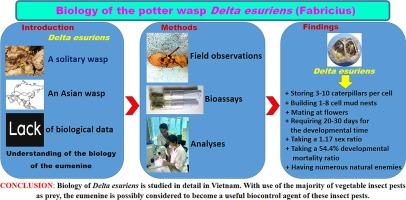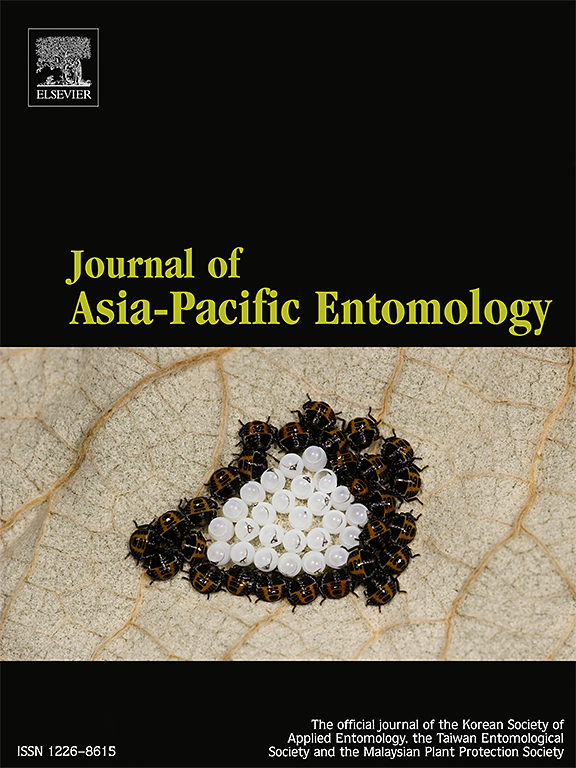陶蜂 Delta esuriens (Fabricius, 1787)(膜翅目:蜉蝣科:Eumeninae)的生物学特性及其筑巢和交配行为、发育和生态学方面的详细情况
IF 1.1
3区 农林科学
Q3 ENTOMOLOGY
引用次数: 0
摘要
越南对陶蜂 Delta esuriens (Fabricius) 的生物学进行了研究。陶氏胡蜂在许多地方筑泥巢,通常是在有遮荫的地方。巢由1-8个锅状小室组成,有时在巢被完全填满后再覆盖一层泥土。卵是在筑巢之前产下的。雌虫在每个巢穴中贮存3-10条夜蛾科、尺蠖科、啄木鸟科和犁头虫科的毛虫,产卵和贮卵期间巢穴是敞开的。在实验室条件下,从卵到成蜂的发育时间为 20-30 天。D.esuriens的交配通常在早晨在Bidens pilosa L.和Celosia cristata L.的花朵上进行。雄虫抓住雌虫,用前腿抓住雌虫的前胸,迅速与雌虫交配4-10秒。性别比为 1.17。发育死亡率在实验室条件下为 25%,在自然条件下为 54.4%。Chrysis dissimilis Dahlbom、Chrysis sp.、Trichrysis lusca (Fabricius)、Melittobia sosui Dahms、两种 Sarcophagidae 卫星蝇和小红蚂蚁是杜父鱼的天敌。这项研究有助于更好地了解 D. esuriens 的生物学和生态学,可用于帮助研究三角洲筑巢行为的系统发育和进化,并有助于制定措施,利用这种陶蜂对蔬菜作物中的害虫进行生物防治。本文章由计算机程序翻译,如有差异,请以英文原文为准。

Biology of the potter wasp Delta esuriens (Fabricius, 1787) (Hymenoptera: Vespidae: Eumeninae) with details on its nesting and mating behaviours, development, and ecology
The biology of the potter wasp Delta esuriens (Fabricius) is studied in Vietnam. The eumenine built its mud nests in numerous sites, usually in shaded locations. The nest consisted of 1–8 pot-shaped cells and was sometimes covered with a lay of mud after it was provisioned completely. The egg was laid before provisioning. The female stored 3–10 caterpillars of Noctuidae, Geometridae, Pieridae, and Plutellidae per nest cell, and left nest cells open during egg-laying and provisioning. The developmental time from the egg to the emergence of the adult wasp was 20–30 days under laboratory conditions. Mating of D. esuriens was taken place at flowers of Bidens pilosa L. and Celosia cristata L., usually in the morning. The male seized a female, grasped her pronotum with his forelegs and quickly copulated with her for 4–10 s. Delta esuriens overwintered as prepupae and occurred in the wild for about eight months a year. The sex ratio was 1.17. The developmental mortality ratio was 25 % under laboratory conditions and 54.4 % under natural conditions. Chrysis dissimilis Dahlbom, Chrysis sp., Trichrysis lusca (Fabricius), Melittobia sosui Dahms, two Sarcophagidae satellite flies, and small red ants were predators of the eumenine. This study provides a better understanding of the biology and ecology of D. esuriens, can be used to aid in studies of phylogeny and evolution of the nesting behaviour in Delta, and can help in developing measures to exploit this potter wasp in the biocontrol of insect pests in vegetable crops.
求助全文
通过发布文献求助,成功后即可免费获取论文全文。
去求助
来源期刊

Journal of Asia-pacific Entomology
Agricultural and Biological Sciences-Insect Science
CiteScore
2.70
自引率
6.70%
发文量
152
审稿时长
69 days
期刊介绍:
The journal publishes original research papers, review articles and short communications in the basic and applied area concerning insects, mites or other arthropods and nematodes of economic importance in agriculture, forestry, industry, human and animal health, and natural resource and environment management, and is the official journal of the Korean Society of Applied Entomology and the Taiwan Entomological Society.
 求助内容:
求助内容: 应助结果提醒方式:
应助结果提醒方式:


